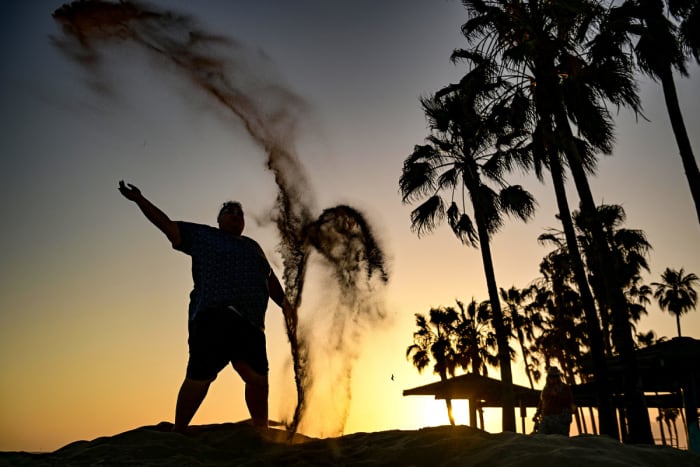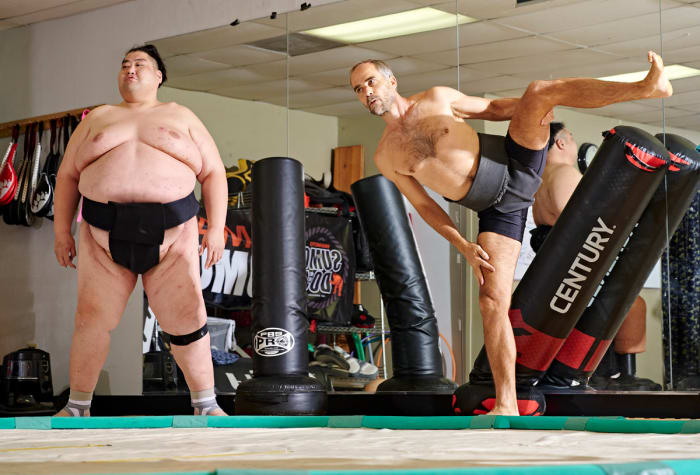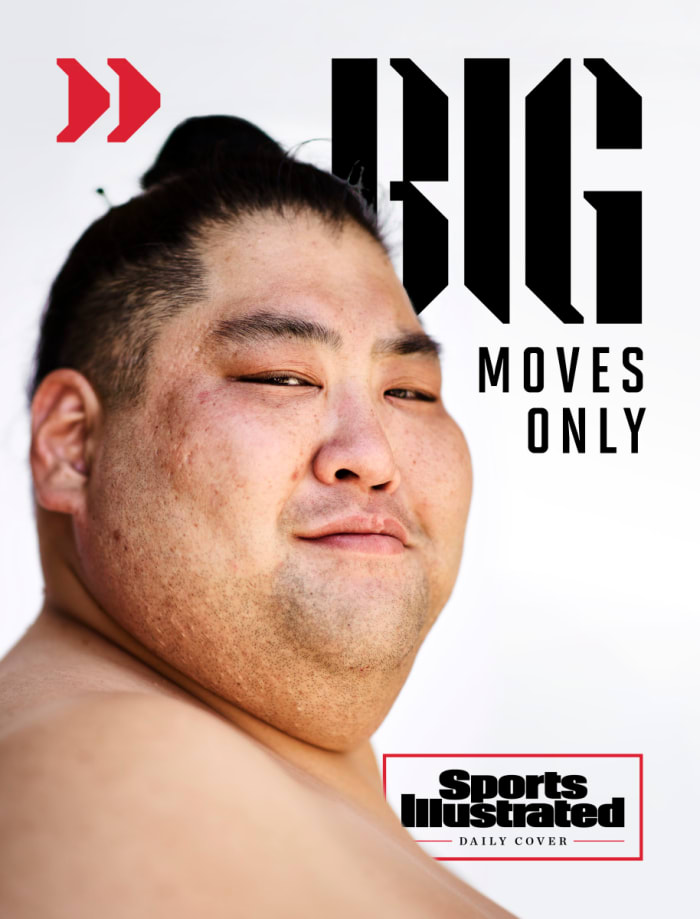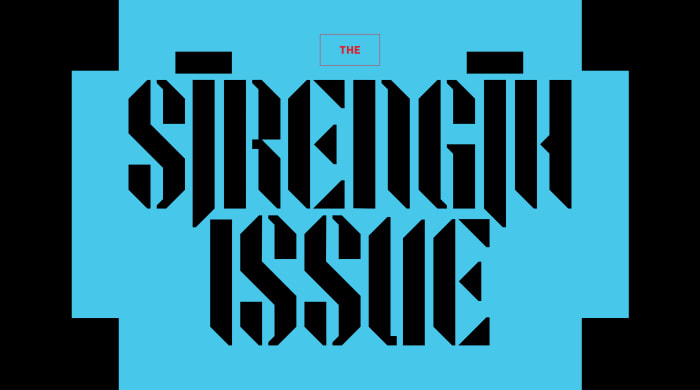Strength comes in many forms and has many sources. But what does it mean to be strong? We have a few ideas. Check back throughout the week for more.
Even as Ryuichi Yamamoto rocketed up the sumo wrestling ranks, winning five national championships as a university student and reaching the highest of six professional divisions in his native Japan, he seemed destined for a life beyond the sport’s austere traditions.
For example, Yamamoto—better known as Yama—recalls getting scolded by broadcast announcers for daring to crack jokes during live postmatch interviews. He also remembers never quite being able to summon the competitive mindset that numerous coaches had preached to him since grade school, which was to imagine that his opponent had murdered his mother and then to respond with a vengeance. And that is without mentioning the physical toll of an all-consuming training regimen that afforded him just two weeks of annual vacation to visit home throughout high school and college.
“Back then, just becoming a stronger sumo wrestler was the best thing in the world we lived in,” Yama, 38, says in Japanese. “Now that I think about it, it was a crazy world.”
Perhaps some people from this old life would make a similar judgment about the new one that Yama now leads. You may not recognize the name, but chances are you have come across his work: On top of making hundreds of appearances in commercials, on news programs and in live demonstrations at events ranging from anime conventions to cultural festivals, Yama has danced alongside One Direction and overhead-pressed Ed Sheeran in music videos; helped form a harem for Owen Wilson’s character in Zoolander 2; and taught sumo to contestants on Season 11 of The Bachelorette. An argument can be made that no other rikishi of his caliber, past or present, has achieved this level of global reach.
Throughout his competitive career, Yama saw himself becoming a ringside commentator whenever his grappling days were done. But those plans changed in spring 2011, when he and 18 fellow wrestlers were implicated in a yaocho (match-fixing) scandal and forced to retire. “I was doing it although I knew it was wrong,” Yama, then competing in sumo’s third division, says now. “To tell the truth, you were not fighting as hard as you could.” Reflecting on his departure, Yama expresses anger for what he views as sumo leadership scapegoating a few to mask a widespread—and widely acknowledged—practice where wrestlers intentionally lost matches to help their friends avoid relegation. “But I thought [the directors] were the ones who created the system and we just followed it,” Yama says.
And yet he also remembers being hit with a sense of relief: “I felt, Oh, I don’t have to do sumo anymore.” As for what to do next, Yama had no clue. Then he received a letter from Andrew Freund, founder of the U.S. Sumo Open—at 22 years strong this coming September, the longest-running tournament outside of Japan—and something of a manager and cultural liaison for ex-pro sumos seeking work Stateside. “I hated to see him lose his career that way,” Freund says. “But it was an opportunity to do something he’d never done.”
Sensing that the yaocho scandal had closed off all future sumo employment doors for him back home—”There was no place for me in Japan, really”—Yama made the blind leap. His first gig was a demonstration at the 2011 Kansas City Japan Festival, the first time in his life traveling anywhere in the U.S. other than New York and Hawai'i. From there he booked a Doritos commercial, appeared on a couple of local news programs, settled in Los Angeles, and never looked back.
“If other professional wrestlers who quit sumo in Japan are asked to do the same thing as I did, I wonder how many of them could actually do it,” Yama says. “I don’t think anyone could.”

Since moving to Los Angeles, Yama has taken time to ride his bike and spend time at the beach.
Kohjiro Kinno/Sports Illustrated
At the height of his pro sumo career, Yama was doted upon day and night by three personal-assistant types known as tsukebito, lower-ranking rikishis whose responsibilities included buying his groceries, managing his finances and handling other such menial tasks so he could focus solely on pushing his opponents out of the dohyo (ring). “They kind of spoil the top-level guys,” Freund explains. “Here, doing everything on his own, it wasn’t just a cultural change [for Yama]. It was a lifestyle change.”
It was also a rocky one at first. “Opening a bank account, getting a mobile phone, getting a social security number, I had a lot of difficulties,” Yama says. “I went to a restaurant, but I could not even order water [due to the language barrier]. I said, ‘Water, water.’ They brought cola.” But over time he found his footing, leaning on a tight support network of Freund and friends from Los Angeles’ Little Tokyo, including a Buddhist priest whose former temple in Japan hosts an annual sumo tournament.
Then there was Byamba. If anyone in the world understood what Yama was going through, it was Byambajav Ulambayar, an ex-pro sumo wrestler from Mongolia who first relocated to the U.S. in 2006 for a cameo role in Ocean’s Thirteen. And while Byamba died following a long illness in early ’20, at just 35, he blazed a trail in Tinseltown for Yama to follow. “He was my role model so I copied everything I could from him,” Yama says. “I couldn’t do anything else but to imitate him.”
Where Byamba captivated audiences with an arsenal of athletic maneuvers and muscular poses, though, Yama realized that his future lay on the other side of the stage: “I think I am more suited for movies, learning toward fiction.” But Yama also has range; to date, the most memorable gig of his career took place in late 2016 at a park in Montreal, on the set of John Wick 2. Playing a suited-up assassin who tries (and ultimately fails) to take out the titular hitman, Yama loved working with Keanu Reeves, finding him to be refreshingly down to earth. “During my scene it was raining,” Yama says. “Despite that, he didn’t go inside his trailer and [instead sat] on the same bench we sat, and he was smoking. I was impressed he did not show off like, ‘I am great.’” But the shoot was also significant because, as Yama notes, it was his first time on camera wearing something other than his usual mawashi loincloth.
Read More From SI’s Strength Issue
As the heaviest Japanese rikishi in recorded history at close to 600 pounds, Yama understands that the joke often starts and stops with his look. “Americans think sumo wrestlers are just fat naked guys hugging each other,” he says. “I try to tell myself that’s how the Americans perceive us because they don’t know. That’s why they say something rude. That’s it. If they learn, they will change their thinking.”
Still there will always be those who seek to use sumo for personal gain, cultural appropriation be damned. One noteworthy example came earlier this year, when Elon Musk challenged Vladimir Putin to a fight by tweeting a picture of himself, from 2014, wearing a kimono and facing off against Byamba as supposed proof of the billionaire’s combative prowess. “I shouldn’t say this, but Elon, he sucked,” Freund says. “Our guy just stood there to try to let him push him, and Elon just fell down by himself again and again.” And while Yama wasn’t at the billionaire’s Japanese steampunk-themed 43rd birthday party, he isn’t afraid to speak out if he feels concepts cross a line, pointing to a shoot for a Nicki Minaj video last August when Yama and another sumo wrestler refused to don leashed collars so the rapper could walk them like dogs. “That was insulting, totally,” Yama says. “They really lack respect.” (According to Freund, the whole scene was scrapped from the final video. Minaj’s camp didn’t respond when asked for comment.)
Where once he was defined by that single-minded mission—become stronger—today Yama works on multiple fronts toward his new goal of spreading sumo. Surface-level representation in mass media is one. Another involves planting seeds at the grassroots level as a volunteer coach alongside Freund with USA Sumo, which plans to send 19 wrestlers to compete at the 2022 World Games in Birmingham. Why? As he explains, “I think the style of sumo is changing compared with the old days. It looks like sumo is leaning toward power sports. If that’s the case, I think there are chances for Americans … [to] get strong enormously.
“But there is no one who can teach sumo at a deeper level so they get stronger.
“I think I am the only one who can [one day] do that.”

Yama’s career as a sumo instructor is still young, but he believes he has the ability to revolutionize the sport in the United States.
Kohjiro Kinno/Sports Illustrated
Although the two men he describes as his “best friends” aren’t around anymore, between Byamba’s passing and the Buddhist priest having moved away from L.A. several years earlier, Yama continues to find new communities, volunteering weekly at a Little Tokyo information center and occasionally cooking meals for senior citizens. (As a rikishi, Yama was a renowned chef of chankonabe sumo stew.) “My friends in Japan all thought I would not be successful,” he says. “Now, they think I am doing fine.”
When he is not traveling for work, in his relatively newfound spare time, Yama enjoys riding his bicycle along the Pacific coastline; streaming video games like Apex Legends to his 57 Twitch subscribers; and hanging with his wife, Megan—they first met in ’16 and got married last year—and their cat, Hanzo. He is also a huge anime fan, booking a sumo demonstration at last year’s Anime Matsuri convention in Houston with a new sole purpose in mind: “Because I was able to visit the booths,” he says.
Yama brings a similarly joyful spirit to his coaching side gig, seeking to redefine the strict boundaries under which he came up as a kid. “That’s what’s so fun about working with Yama,“ says Kellyann Ball, a 28-year-old accountant from Chino, Calif., who has trained with Yama for the past three years and recently captured gold in the women’s heavyweight division at the 2022 U.S. sumo national championships in Salt Lake. “He tries to make classes not only ‘let’s hit each other,’ but ‘let’s laugh as well.’ ”
That ethos is evident on the first Sunday morning in May, when the Yamamoto Sumo Dojo convenes for its first practice following nationals, inside a karate studio next to a foot massage spa and a 99-cent store. Yama arrives early, wearing a fanny pack across a dress shirt decorated with palm trees and a pair of Crocs bearing Toy Story alien charms on his size-16 feet. Stepping behind a curtain, he changes into his mawashi, flops onto the matted floor and sweats through a methodical stretching routine that ends with him pounding his thighs as he performs a full-legged split.
Among the half dozen students present is a 9-year-old boy who started learning sumo back home in Japan before his parents relocated to the Los Angeles area. Absent anyone his own age to spar with, the boy steps into the dohyo and crouches down against Yama, topknot to topknot. Charging ahead, the boy plants his feet and slaps his palms against Yama’s belly. Receiving the blow with a focused—if fake—grunt, Yama stumbles half a step backward. The boy charges again, Yama faux-retreats again, and the whole sequence repeats until the retired rikishi is shoved from the ring.
“Nice,” Yama says, smiling and gently patting the boy on the head.
“Arigato,” the boy replies with a giggle.
Read More Daily Covers:
• ‘Oh, You Look Like The Rock’: Finding Rocky’s Family
• Kelly Slater Won the Super Bowl of Surfing at 50. So, What’s Next?
• NBA Draft? Nah. He’s Following the Money, Right Back to School.








